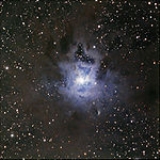
Iris nebula
Encyclopedia
The Iris Nebula, also NGC 7023 and Caldwell 4, is a bright reflection nebula
and Caldwell object
in the constellation
Cepheus
. NGC 7023 is actually the cluster
within the nebula
, LBN 487, and the nebula is lit by a magnitude
+7 star, SAO 19158. It shines at magnitude +6.8. It is located near the Mira-type variable
star T Cephei
, and near the bright magnitude +3.23 variable star Beta Cephei
(Alphirk). It lies 1,300 light-year
s away and is six light-years across.
Reflection nebula
In Astronomy, reflection nebulae are clouds of dust which are simply reflecting the light of a nearby star or stars. The energy from the nearby star, or stars, is insufficient to ionize the gas of the nebula to create an emission nebula, but is enough to give sufficient scattering to make the dust...
and Caldwell object
Caldwell catalogue
The Caldwell Catalogue is an astronomical catalog of 109 bright star clusters, nebulae, and galaxies for observation by amateur astronomers. The list was compiled by Sir Patrick Caldwell-Moore, better known as Patrick Moore, as a complement to the Messier Catalogue.The Messier Catalogue is used...
in the constellation
Constellation
In modern astronomy, a constellation is an internationally defined area of the celestial sphere. These areas are grouped around asterisms, patterns formed by prominent stars within apparent proximity to one another on Earth's night sky....
Cepheus
Cepheus (constellation)
Cepheus is a constellation in the northern sky. It is named after Cepheus, King of Aethiopia in Greek mythology. It was one of the 48 constellations listed by the 2nd century astronomer Ptolemy, and remains one of the 88 modern constellations.-Stars:...
. NGC 7023 is actually the cluster
Star cluster
Star clusters or star clouds are groups of stars. Two types of star clusters can be distinguished: globular clusters are tight groups of hundreds of thousands of very old stars which are gravitationally bound, while open clusters, more loosely clustered groups of stars, generally contain less than...
within the nebula
Nebula
A nebula is an interstellar cloud of dust, hydrogen gas, helium gas and other ionized gases...
, LBN 487, and the nebula is lit by a magnitude
Apparent magnitude
The apparent magnitude of a celestial body is a measure of its brightness as seen by an observer on Earth, adjusted to the value it would have in the absence of the atmosphere...
+7 star, SAO 19158. It shines at magnitude +6.8. It is located near the Mira-type variable
Mira variable
Mira variables , named after the star Mira, are a class of pulsating variable stars characterized by very red colors, pulsation periods longer than 100 days, and light amplitudes greater than one magnitude in infrared and 2.5 magnitude in visual...
star T Cephei
T Cephei
T Cephei is a Mira variable hypergiant star in the constellation Cepheus. With its radius of 540 solar radii, it is one of the larger known stars.-References:*...
, and near the bright magnitude +3.23 variable star Beta Cephei
Beta Cephei
Beta Cephei is a third magnitude star in the constellation Cepheus. It has the traditional name Alfirk , meaning "The Flock" This star, along with α Cep and η Cep , were Al Kawākib al Firḳ , meaning "the Stars of The Flock" by Ulug Beg...
(Alphirk). It lies 1,300 light-year
Light-year
A light-year, also light year or lightyear is a unit of length, equal to just under 10 trillion kilometres...
s away and is six light-years across.

